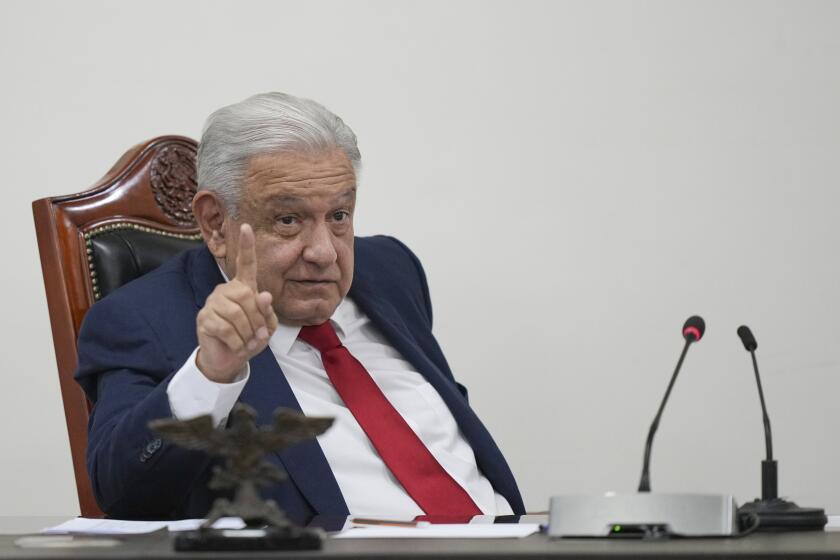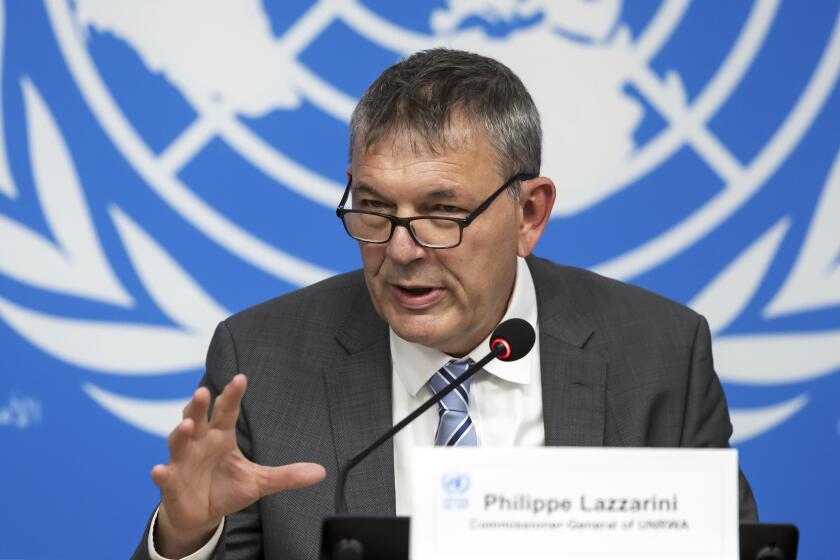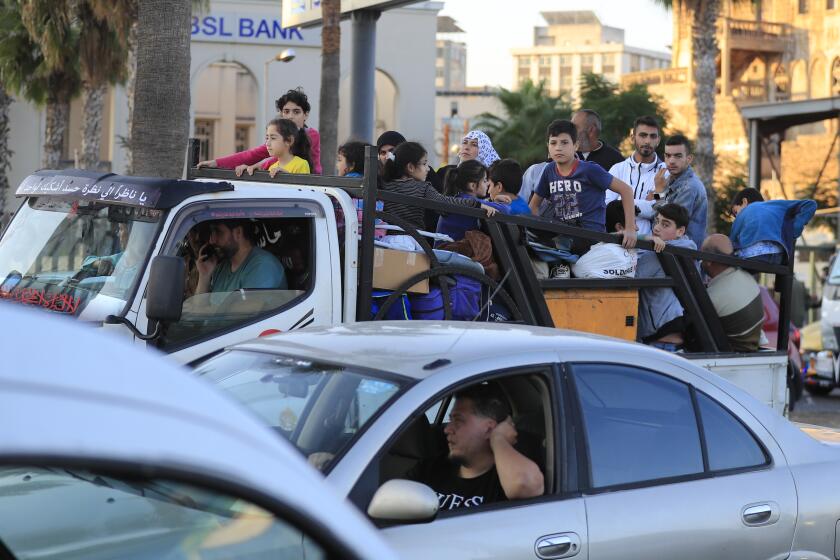Generals or Civilians : The Latin Drama: Who Are Rulers?
Around midnight on June 18, police and troops commanded by an army general attacked rebellious guerrilla prisoners barricaded inside a cellblock at Lurigancho prison here.
Between 15 and 18 of the 124 prisoners, members of the Maoist Sendero Luminoso insurgency, died in the assault. The rest were killed after they had surrendered. At dawn, a general on the phone awoke a Cabinet minister for a brief conversation that the civilian remembers starkly:
“The mission was a complete success,” the general reported.
“Good. How many prisoners died?” the minister asked.
“One hundred percent.”
“What! How can that be?”
“There was no alternative,” the general replied.
Murder Charges
More than two dozen members of the Republican Guard, a militarized police force, and an army general are now charged with murder at the insistence of Alan Garcia, Peru’s populist president.
Garcia, like other elected leaders in Latin America’s new democratic governments, seeks to assert the supremacy of civilian authority over his armed forces. It is an uphill struggle: Garcia is whipsawed between his support for human rights and his need to conquer Maoist guerrillas. The generals are restless.
“Either they go or I go,” Garcia said of the uniformed killers during a visit with the press to the killing ground at Lurigancho.
Now behind bars awaiting trial, Peru’s prisoners who killed prisoners are characters in a Latin American drama being played out behind the scenes these days from Panama to Argentina. Sometimes, in violence, there are headlines. Most often, the plots can only be dimly perceived, readable between the lines. The drama’s central question is always the same: Who really rules here?
Discounting contorted Central America, seven Latin American republics ruled by generals in 1979 are headed today by civilians. In each of them, armed forces weaned on power and wedded to its exercise restively eye the successors seeking to consolidate the principle of civilian authority.
Low-Key Rivalry in Brazil
The military-civilian rivalry can be as low-key as it is in Brazil, where the military withdrew from power after 21 years but refused to allow free elections to choose a replacement, and as overt as in Panama, where strongman Gen. Manuel A. Noriega bounced two civilian presidents in less than two years for unseemly shows of independence.
The ongoing test of authority occurs in countries where constitutions echo the U.S. concept of the president as commander in chief, but history insists that the president only really commands the armed forces when he is also a general.
“It remains to be seen whether Latin America’s current civilian cycle is lasting, but it is clear that, even out of power, the nature of the military establishments has not changed,” said Wayne S. Smith, director of Argentine studies at Johns Hopkins University in Baltimore. “The armed forces continue to view themselves as above politics, arbiters of power and defenders of the nation. Ever alert to internal enemies, which usually means anyone left-of-center, they decide when the nation is in danger.”
A so-called doctrine of national security espoused by most Latin American armed forces holds that the military’s role is not only to protect against foreign enemies but also to intervene in times of domestic political tumult, especially as an antidote to the spread of subversion, which is usually defined as international communism.
“The armed forces cannot be just spectators before chaos and disorder,” Gen. Leonidas Pires Goncalves, Brazil’s army minister, said last week in lobbying for a national security statute in a new Brazilian constitution.
Historic Clout
The Argentine armed forces urged the Senate last week to approve a new defense law that would authorize their intervention against “all types of aggression, or circumstances that attack national security, whatever the origin.”
Given their self-assigned mission and their historic clout, it is less surprising that the armed forces of the newly democratic governments should balk at civilian control than that the civilians have thus far managed to survive.
In Ecuador early this year, a conservative civilian government put down the revolt of an air force general.
In Bolivia, where military rebellions in the past have been more common than constitutional successions, the year-old government of reformer President Victor Paz Estenssoro has outlasted several cycles of coup rumors. Last week, Paz declared a new state of siege to handle fresh threats of instability, this time coming from labor and political sectors of the extreme left.
Galling to Generals
Colombia’s sturdy democracy is on track, but people still shiver at the memory of a so-called “27-hour coup” last November, when leftist guerrillas took over the Palace of Justice in downtown Bogota, and the armed forces blasted their way in. More than 100 people, including 11 justices of the Supreme Court, died in the ensuing pitched battle.
Adjustment from tightly controlled military dictatorship to usually disordered civilian rule is painful for both sides. The raucous exercise of democratic forms, particularly in a political arena where not all the parties who take advantage of new freedoms are themselves democratic, is especially galling to the generals.
There have been some victories: Argentina’s President Raul Alfonsin has slashed military spending and Peru’s Garcia has aborted the purchase of sophisticated jet fighters and a costly refurbishing of the Peruvian navy’s white-elephant flagship.
A Difficult Job
Still, the generals fume at budget cuts, at civilian oversight, at congressional inquiry, at press criticism, at the appearance on street corners of pornography and recruiters for the Marxist parties they once hunted.
For civilian rulers, asserting authority while simultaneously smoothing ruffled feathers is a trying job. Garcia’s minister of defense is, typically, an army general. Alfonsin’s is, unusually, a civilian, the third to hold the post since 1983: The first two died in office.
When challenged legally, Latin America’s armed forces shelter in parallel military justice systems often more protective than judicious. They are particularly sensitive at being called to account for their actions while they ruled.
‘Responsible, Not Guilty’
In Uruguay, which returned last year to its historic pattern of democratic government, President Julio Sanguinetti is enmeshed in his gravest political crisis over an amnesty bill that would forgive human rights abuses by military and police officers during a 12-year dictatorship. The initiative is attacked by all opposition political parties, by human rights groups, by a populace that bangs pans at night in protest, and by the armed forces themselves. The generals say there is nothing for which they need be forgiven.
That attitude is shared by the armed forces of Argentina.
“I am responsible, but I am not guilty,” Adm. Emilio E. Massera told a court that sentenced him to life imprisonment for human rights violations during Argentina’s 1976-80 “dirty war” against Marxist-led terrorists in which at least 9,000 people disappeared.
Argentina’s trial last year of nine former military junta members, including three former presidents, was a landmark not only for Argentina, but for all of Latin America.
No Convictions
It occurred only after civilian courts took jurisdiction from military tribunals, which had refused to act. A few months after his conviction, Massera was pictured in an Argentine magazine strolling unguarded in gym clothes toward a squash court in his military prison.
Despite specific allegations against nearly 1,000 police and armed forces personnel by Argentine human rights groups, there have been no convictions since the commanders’ trial.
A group organized in Buenos Aires by the armed forces called Relatives and Friends of Those Killed by Subversion sponsors a well-publicized monthly Roman Catholic Mass attended by prominent retired and sometimes active-duty officers. After one Mass, the congregation reassembled outside the church to cheer former President Jorge R. Videla, also under sentence of life in jail, and to chant: “Death to the traitors!”
Notable Strains
Here in Peru, where the ultranationalistic Garcia sometimes sports a baton and a one-of-a-kind commander-in-chief uniform, there are notable strains between the executive and the armed forces that last ruled between 1968 and 1980. The hostility between the generals and Garcia’s 60-year-old party, the American Popular Revolutionary Alliance, is historic, deep-seated and not easily overcome.
“Our uniformed forces are not accustomed to the exercise of civilian authority. As a result, there are inevitable frictions, but I honestly don’t see it as a conflict of powers,” said Abel Salinas, Peru’s civilian minister of interior and the Cabinet officer in charge of police.
Julio Cotler, head of a private think tank called the Institute of Peruvian Studies, takes a less sanguine view.
“It is a question of power. Garcia has been unable to dismantle the (military) political apparatus. The armed forces remain a state within a state,” he said recently.
Free Hand Sought
Like Alfonsin and Sanguinetti, Garcia is a strong human rights defender. And, like them, his advocacy invites strain with his armed forces. The Peruvian generals want a free hand to combat the Sendero Luminoso (Shining Path), an Andes-based guerrilla movement that has spread to Lima and other major cities and is Garcia’s greatest domestic challenge.
Last fall, an army patrol led by a young lieutenant slaughtered Sendero suspects in an Andean village. The lieutenant went to jail and Garcia promptly sacked his faraway commander, Peru’s only combat general. In fury, the army allowed that. Its response was to quietly reduce patrols in the Andean guerrilla areas by two-thirds, well-placed Peruvian sources say.
Until recently, army commanders supposedly hunting guerrillas in coca-growing regions east of the Andes restricted the forays of U.S.-sponsored narcotics police but would not act themselves against the cocaine trade. The army’s job was national security, to fight guerrillas, the argument went; the anti-drug campaign was not the army’s problem. Only recently, too, did the Peruvian air force stop charging the government’s drug enforcement officials mileage for the use of air force planes and helicopters.
Costly Assault
The army has had scant success against Sendero Luminoso. The Civil Guard and other Peruvian police forces, still smarting from Garcia’s having axed hundreds of the most corrupt senior officers, have done no better.
When Garcia ordered the army and police to recapture rebellious Sendero prisoners at Lurigancho and the island prison of El Fronton last June, he believed that the assault might cost up to 50 lives, according to a Peruvian official present when the presidential decision was made.
Instead, at Lurigancho, all 124 Sendero convicts died. At El Fronton, where there was resistance by the convicts, the toll was even higher, although no official count has ever been released.
Peruvian observers are divided about whether the prison excesses occurred in hot blood, a result of poor leadership, or if the military deliberately exceeded its orders. Either way, Garcia’s moral and political authority suffered.
Ship Was Carrying Arms
Even as the prison events convulsed Peru, a sideshow was playing. U.S. intelligence warned Garcia of a load of East German arms aboard a Danish freighter approaching the Peruvian coast.
Garcia ordered the navy to track it down. Nothing happened for three days, according to well-placed Peruvian sources. By the time patrol boats and aircraft got around to looking, the freighter Pia Vesta was out of Peruvian waters.
The ship was intercepted in Panama, after Garcia asked strongman Noriega to stop it. For the past two months, a tangled paper chase here has failed to clarify the intended destination of the Pia Vesta’s falsely manifested cargo of 1,440 anti-tank rockets, 1,500 automatic rifles and 32 trucks.
‘Ridiculous Fiasco’
There are as many fancied buyers as there are political interests at play: the contras fighting Nicaraguan’s Sandinista government; the Sandinistas themselves; Sendero Luminoso; or even perhaps Garcia’s party.
Some officials here think the arms, with a factory price of $1.5 million, were intended for the Peruvian navy, which had no government authorization to buy them. More likely, other officials maintain, the arms were being bought for resale by naval officers unaccustomed to the strictures of life under civilian rule.
“There was never anything clandestine about that shipment. The whole thing’s a ridiculous fiasco,” David Duncan, the arms broker who claims to have arranged the sale, said in a phone interview from Miami. “The Peruvian navy officers I sold it to just didn’t have the guts to tell their president.”
More to Read
Sign up for Essential California
The most important California stories and recommendations in your inbox every morning.
You may occasionally receive promotional content from the Los Angeles Times.










